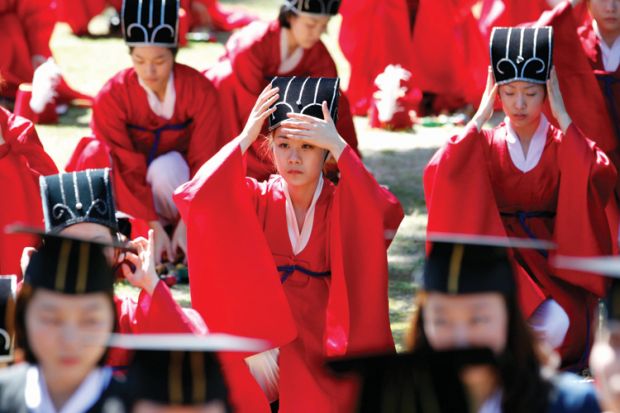View the full 100 Under 50 2014 rankings results
Claim a free copy of the 100 Under 50 supplement
East Asian universities continue to lead a ranking of the world’s top 100 universities under 50 years old, which provides insight into which nations could be poised to challenge traditional Anglo-American dominance of higher education.
The top four institutions in the Times Higher Education 100 Under 50 2014 rankings all retain their position from last year, with South Korea’s Pohang University of Science and Technology (Postech) taking the top spot for the third consecutive year.
Switzerland’s École Polytechnique Fédérale de Lausanne is in second place, with the Korea Advanced Institute of Science and Technology (KAIST) positioned third. Hong Kong University of Science and Technology retains fourth position, while Singapore’s Nanyang Technological University strengthens the Asian dominance of the top five by jumping three places to fifth.
“The academy’s traditional, ancient elite should be warned,” said Phil Baty, THE rankings editor.
“The data prove that nations can, in a matter of years, with the right support and vision, create world-class universities to compete with traditional institutions that have had many centuries to develop.”
Some of the “plate-glass universities” established in the UK in the early 1960s are now too old to feature in these rankings, meaning that there has been a steep decline in the country’s representation in this year’s results. It now has 14 institutions, compared with 18 last year. Just one UK institution, Lancaster University, makes it into the top 10 (10th, up from 14th last year).
Of the UK’s other representatives, only two were founded after the 1960s – both former polytechnics that gained university status in 1992. Plymouth University moves up to joint 42nd from joint 53rd, while the University of Hertfordshire rises 15 places to joint 60th.
Meanwhile, Heriot-Watt University (52nd) has overtaken the University of Stirling (56th) as Scotland’s top young university, with the University of Strathclyde (78th) the country’s only other top 100 institution.
Australia now ties with the UK as the most represented nation, with 14 institutions (up from 13 last year), while Spain increased its representation from six to seven institutions. Of the five “Brics” nations, three of them – Russia, mainland China and South Africa – fail to make the grade, although there is good news for India, with the Indian Institute of Technology, Guwahati, breaking into the top 100.
“While they may not have had centuries to accumulate wealth and cannot draw on generations of alumni and rich traditions of scholarship to drive their reputations, they are free from the burdens of history,” Mr Baty said.
“They are free to be more agile, lean, flexible and risk-taking, giving them an advantage in a rapidly changing global marketplace; free to offer innovative teaching and focus their research on niche, high-impact areas.”
Listen to the 100 Under 50 2014 rankings podcast
THE 100 under 50 2014 rankings: top 10 universities
| 2014 | 2013 | WUR | Founded | Institution | Country |
|---|---|---|---|---|---|
| WUR = Times Higher Education World University Rankings 2013-14 | |||||
| 1 | 1 | 60 | 1986 | Pohang University of Science and Technology | South Korea |
| 2 | 2 | 37 | 1968 | École Polytechnique Fédérale de Lausanne | Switzerland |
| 3 | 3 | 56 | 1971 | Korea Advanced Institute of Science and Technology (KAIST) | South Korea |
| 4 | 4 | 57 | 1991 | Hong Kong University of Science and Technology | Hong Kong |
| 5 | 8 | 76 | 1991 | Nanyang Technological University | Singapore |
| 6 | 6 | 98 | 1976 | Maastricht University | Netherlands |
| 7 | 5 | 93 | 1965 | University of California, Irvine | US |
| 8 | 10 | 114 | 1971 | Université Paris-Sud | France |
| 9 | 9 | 96 | 1971 | Université Pierre et Marie Curie | France |
| 10 | 14 | 137 | 1964 | Lancaster University | UK |
Better together?: it is better to start afresh
Merging existing institutions is a less effective way of producing new “world-class” universities than creating them from scratch, a global tertiary education expert has told Times Higher Education’s inaugural Young Universities Summit.
Jamil Salmi, former World Bank tertiary education coordinator, was critical of mergers in Russia, which he said had been imposed by government without consideration for academic compatibility, and in France, where “unwieldy” institutions had been created when universities joined together.
“The idea is that by merging, the end result will be more than the sum of its parts,” he said at the event in Miami on 28 April. “The mergers in Russia…were imposed by the government [and] did not happen because two or three institutions wanted to come together.”
Dr Salmi also expressed concern about the merger in France between the University of Provence, the University of the Mediterranean and Paul Cézanne University, which created Aix-Marseille University – one of the largest in France.
“In some cases you have mergers where all of a sudden you have an institution with more than 100,000 students and I think it is really challenging – it is like managing a small city and it becomes unwieldy,” he told THE.
The summit – held in partnership with Plymouth University – celebrated the successes of the world’s younger universities.
Register to continue
Why register?
- Registration is free and only takes a moment
- Once registered, you can read 3 articles a month
- Sign up for our newsletter
Subscribe
Or subscribe for unlimited access to:
- Unlimited access to news, views, insights & reviews
- Digital editions
- Digital access to THE’s university and college rankings analysis
Already registered or a current subscriber? Login





